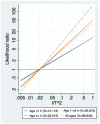Combining immature and total neutrophil counts to predict early onset sepsis in term and late preterm newborns: use of the I/T2
- PMID: 24503598
- PMCID: PMC4122647
- DOI: 10.1097/INF.0000000000000297
Combining immature and total neutrophil counts to predict early onset sepsis in term and late preterm newborns: use of the I/T2
Abstract
Background: The absolute neutrophil count and the immature/total neutrophil ratio (I/T) provide information about the risk of early onset sepsis in newborns. However, it is not clear how to combine their potentially overlapping information into a single likelihood ratio.
Methods: We obtained electronic records of blood cultures and of complete blood counts with manual differentials drawn <1 hour apart on 66,846 infants ≥ 34 weeks gestation and <72 hours of age born at Kaiser Permanente Northern California and Brigham and Women's Hospitals. We hypothesized that dividing the immature neutrophil count (I) by the total neutrophil count (T) squared (I/T) would provide a useful summary of the risk of infection. We evaluated the ability of the I/T to discriminate newborns with pathogenic bacteremia from other newborns tested using the area under the receiver operating characteristic curve (c).
Results: Discrimination of the I/T (c = 0.79; 95% confidence interval: 0.76-0.82) was similar to that of logistic models with indicator variables for each of 24 combinations of the absolute neutrophil count and the proportion of immature neutrophils (c = 0.80, 95% confidence interval: 0.77-0.83). Discrimination of the I/T improved with age, from 0.70 at <1 hour to 0.87 at ≥ 4 hours. However, 60% of I/T had likelihood ratios of 0.44-1.3, thus only minimally altering the pretest odds of disease.
Conclusions: Calculating the I/T could enhance prediction of early onset sepsis, but the complete blood counts will remain helpful mainly when done at >4 hours of age and when the pretest probability of infection is close to the treatment threshold.
Figures



References
-
- Manroe BL, Rosenfeld CR, Weinberg AG, Browne R. The differential leukocyte count in the assessment and outcome of early-onset neonatal group B streptococcal disease. J Pediatr. 1977 Oct;91(4):632–637. - PubMed
-
- al-Mulla ZS, Christensen RD. Neutropenia in the neonate. Clin Perinatol. 1995 Sep;22(3):711–739. - PubMed
-
- Berger C, Uehlinger J, Ghelfi D, Blau N, Fanconi S. Comparison of C-reactive protein and white blood cell count with differential in neonates at risk for septicaemia. Eur J Pediatr. 1995 Feb;154(2):138–144. - PubMed
-
- Da Silva O, Ohlsson A, Kenyon C. Accuracy of leukocyte indices and C-reactive protein for diagnosis of neonatal sepsis: a critical review. Pediatr Infect Dis J. 1995 May;14(5):362–366. - PubMed
-
- Greenberg DN, Yoder BA. Changes in the differential white blood cell count in screening for group B streptococcal sepsis. Pediatr Infect Dis J. 1990 Dec;9(12):886–889. - PubMed
Publication types
MeSH terms
Grants and funding
LinkOut - more resources
Full Text Sources
Other Literature Sources
Medical

